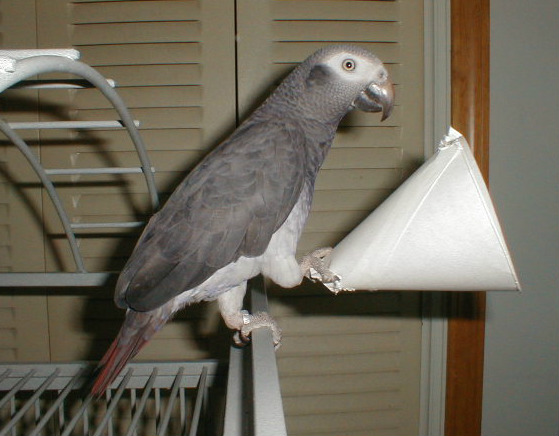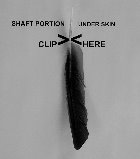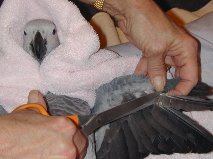|
Your Companion
Bird and You
|
|
Owning a parrot is one of the most rewarding experiences a person can have. But like all things that are worth doing, it is worth doing well. Birds are very special beings. They are blessed with a high level of intelligence and capable of enriching their owner's lives in hundreds of ways. The owner who takes the time to understand this specialness and treats his bird with gentleness, compassion and love will be rewarded with joy, love, trust and an unforgettable relationship in return. In my previous article, I concentrated on the socialization and behavioral aspects of getting to know your new bird. This article addresses many of the other areas that are important to your bird's well being and his interaction with you. FOODS Continue to expose him to new foods, new tastes, new colors, new shapes. Don't allow him to get bored with the same old tastes day after day. Experiment - offer him a carrot stick or a piece of romaine lettuce when you make your salad for dinner. Allow him to share a piece of toast with you in the morning. Some birds like eggs - since eggs can contain salmonella, they must be very well done if offered to the bird. Eating is a social activity in a flock and your bird will enjoy his own dish at dinner. Feed him or share your dinner with him. Don't give him his favorite treat day after day - offer a nut meat (use human grade nuts, unsalted), a half of a grape, a small piece of apple, cinnamon rice cake, a small piece of pizza (no meat). Only your imagination and the bird's acceptance limit treats. Birds are messy with their food. In the wild this flinging, pitching and dropping half-eaten food ensures the next generation of food trees or shrubs because the ground is littered with seeds awaiting their time in the sun. If you want stucco walls, feed your bird bananas. A well-enjoyed pomegranate will spot nearby objects a very attractive red. Forewarned is forearmed. TOYS Rotate his toys so there will always be something new even if this new toy was a toy he had last month. Chewing is an important activity. Always have a couple of chewable, killable toys. He may also like to chew his perches. Using natural branches with the bark intact may be very attractive to him. Willow, although a soft wood, is much loved by birds. He can also be offered small Willow twigs for a hand-held good chewing time. If he actually consumes the wood, naturally he can't have it. All parts from a tree must be washed. I have never had a bird actually ingest his toys but it is something to be watched for. PERCHES The most comfortable and affordable perch is a natural branch. The bird's nails should touch the branch but larger and smaller diameters on the same branch will give him foot exercise. A smooth unvarying perch (such as the round oak perch) is asking for foot and hip trouble. Replace perches as necessary. Naturally the branches must be a safe wood from a tree that has never been sprayed and must be scrubbed and disinfected before use. WING AND NAIL CLIPPING I give Greys a very conservative wing trim - usually the first four flight feathers. Greys are heavy bodied birds and if they are clipped too severely, it can cause serious injury to the breast and/or sternum when fluttering down to the floor from the cage. With a very severe clip, a bird can actually rip his tail (the preacher's nose area) from his body with a clumsy landing, break his sternum or break a portion off his beak. Please see my article Wingclipping and the African Grey. Observe the bird carefully after the clipping. Sometimes I will have a particularly strong or skillful parrot who flies further than I want him to fly. I aim for 15 feet without altitude gain. This flight path will ensure that the bird has enough lift to land safely. If a bird flies more than 15 feet, I clip one more flight feather off of each wing. Lift up the coverts (from the underside of the wing) and clip the flight so that it is above the first line of coverts. The stub is sandwiched between the outer wing coverts and the under wing coverts. This will ensure that the stub doesn't irritate or poke into the bird's flank. Of course, each feather must be checked to make sure you don't cut into a growing or blood feather. The coverts are the short overlapping feathers that cover the base of the flights. Observe your bird for flight length and altitude and clip as many flight feathers as are necessary.
Clipping a bird does not render the bird flightless. Never, under any circumstances, take your bird outside unless he is in a carrier, in a cage or wearing a harness. A gust of wind can mean a lost bird. I never clip the babies until they have learned to control their flight, land where they intended to land and land on the floor safely. Often this means I am dodging several babies practicing flying. Once the babies learn they can really and truly fly, they tend to settle down, eat better and get on with the business of weaning. Losing weight during weaning is instinctive and unavoidable. Since flying is such an important activity, they may need a couple of flight feathers clipped after several weeks of flying to allow them to refocus on eating. The babies are so strong and muscular from several weeks of flying, they can regain the ability of fly after the light trim but flying is not so all consuming. Warm foods can be offered by hand during weaning. Soaking Zupreem Primate Biscuits (no other brand) in hot water until they are soft, then tearing them into bite size pieces, and chasing a bird around until you can get him to eat. Warmed birdie bread can also be offered. It is possible, using de-sensitizing methods, to train the bird to stand for toe nail clipping. If a bird's toenails are clipped a tiny bit weekly, the quick will recede and bleeding will seldom occur. This avoids pain for the bird and makes him more tractable during needed nail care. After the bird becomes comfortable with and trusts the new owner, a nail file can be a good tool for beginning the de-sensitizing process. After the bird is comfortable with the new owner spreading his wings, it is possible to clip the wings without distressing the bird. It is critical that the bird be placed on a surface or substrate that is not slippery. During this de-sensitizing period, be very careful and don't let anything untoward happen. The bird needs to believe that these exercises are harmless. Clipping the barest point off of a nail will not cause any pain or discomfort and will reassure the bird that nail clipping is not to be feared. As I mentioned in the socialization article, a very slow and careful routine will work best. The wing clipping exercise can begin with an examination of the scissors. Manipulate them - opening and closing them several times. Have them in the bird's sight for however long it takes for him to feel comfortable. Begin the wing opening practice by slowly moving your hand from the back and top of the wings to the sides. Next begin running your thumb under the folded wing. Pay careful attention to his body language. After weeks or months, you should be able to spread his wing. Take as much time as you need. Never rush him. A cue – such as "Pretty wings." – can be effective during this exercise. He may need to be wrapped into a “birdie burrito” if he needs to be restrained during wing clipping. Birdie Burrito - fold a heavy towel in half and grasp the back of the bird’s neck with your hand under the towel. Don’t strangle the bird. Wrap the loose edges of the towel over the bird’s body. Continue to do these exercises even when the bird doesn't need a toenail clip or a wing clip. It will keep the memory fresh for him and serve to remind him that neither form of grooming is to be feared. BATHS I accustom the handfeeding babies to their baths by spray bathing them when the flights and tail feathers emerge. Later when they are perching, I may hold them on my hand over the sink with their toes pinned firmly and scoop very warm water onto their backs and wings with my other hand. All the while I reassure them and tell them what fine brave birdies they are. Some will enjoy playing in a stream of warm water from the faucet. Place something on the bottom of the sink so it isn't slippery. Some may enjoy a shallow bowl of warm water. Others may prefer a misting while being held over the sink or perhaps would be more receptive to a bath in or on the cage. Many birds enjoy showering with their owners. There are PVC perches that attach by suction to the shower walls. Be gentle and reassuring while discovering the method your bird prefers. If you take your bird into the bathroom when you are showering, the bird may well decide to join you. Many owners are successful by placing the bird on the rim of the bathtub. Place a warm damp washcloth or hand towel over the slippery surface for the bird to stand on. The bird can also stand on a towel in the bottom of your shower and bathe in the stream of water. You can also hold him on your hand, turn on the stream of warm water and hold him under the water. HEALTH Weigh recently weaned birds every week. Adults may be weighed twice a month. Keep a diary or calendar and record the weights. Weight loss is often the first indication that something may be wrong. A bird can hide most of the symptoms of illness but weight loss is one thing he cannot hide. Pay attention to your birds' habits, check the poops daily, know how much water the bird drinks typically, how active he normally is. Minor changes, if continued, can indicate the need for a trip to your avian vet. In all cases, have the blood calcium level checked for the first 5 years. Low blood calcium is life threatening - it can cause death if undiagnosed and untreated. Never give a calcium supplement to a companion bird unless directed to do so by an avian vet after a blood calcium level test is run. Don't feed your bird a pellet with extra calcium. Companion birds don't need extra calcium, they need enough calcium. VETERINARIANS Take your bird to an avian vet. Be careful and informed regarding avian health and medicine if your vet doesn't see many birds. The values from the various tests will have significance to the avian vet, whereas the vet who sees few birds may not understand the significance or the relationship of one result to another. A vet who primarily sees cats, dogs and other mammals may prescribe medicines that work very well on mammals but can cause serious liver and kidney damage in birds. Check for a board certified avian vet if possible. Avian research has made your baby healthier and will have a major influence on longevity. Support avian research and donate what you can to it on your baby's birthday. One facility that is doing much in the area of avian research is The University of Georgia, College of Veterinary Medicine, Athens, GA 30602-7371. OTHER PETS A bird should learn "Bad dog!" and/or "Bad cat!" when either of these animals approach his cage. This will alert you that one of these pets are at his cage. Dog and cat bites or scratches, even if the skin is only broken, can result in death within days. If there is any kind of direct encounter, take the bird to your avian vet immediately and explain the circumstances. The vet will prescribe an antibiotic, as the area of broken skin may be too small to be visualized. The bacteria associated with dog and cat teeth and claws are deadly to birds. No interaction between birds and other mammals should ever be encouraged or permitted. LIFE AFTER YOU A bird is forever (almost) and he deserves the very best you and I can offer. Make arrangements in your will for your bird. Many birds have a human life span given regular health care and a nutritious varied diet. Don't allow problems or inappropriate behavior to accumulate or escalate. Don't hesitate to call your breeder, your avian vet, an avian behaviorist or an experienced bird keeper regarding temporary or minor behavioral or health problems... or for recommendations to professionals for your more serious concerns. If anyone you contact suggests a dominance based treatment for parrot problems, break the connection with this person immediately. All rights reserved. No part of this article may be reproduced in any form or by any means, without permission from the author. |


